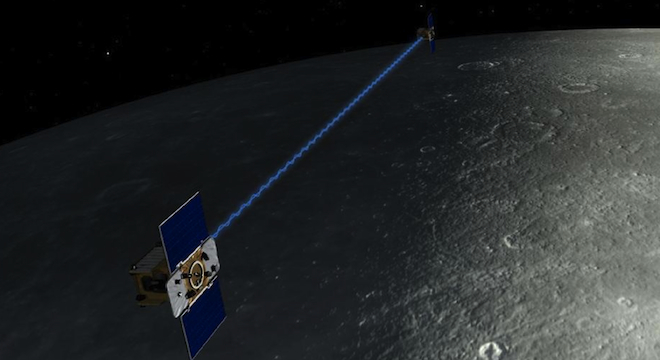NASA is going to be pelting the Moon with two spacecraft, destroying them.
“I wouldn’t say we’re bombing the Moon,” said Maria Zuber, an MIT geophysics professor and the principal investigator of NASA’s Gravity Recovery and Interior Laboratory (GRAIL) mission, in a phone interview with TPM. “They’re not bombs, they’re satellites. Satellites are deorbited from the Earth frequently in controlled deorbits, where they land in the ocean as opposed to on land where they could cause harm to people and structures. We’re taking similar steps.”
The two lunar spacecraft being deorbited in this case are named Ebb and Flow. Launched in September 2011, they’ve been orbiting the Moon since January 2012, in tandem (one following the other), circling in a close, low-altitude trajectory, mapping the Moon’s gravitational field more accurately than ever before.
But now their primary mission is complete and they’re running out fuel. NASA doesn’t want to leave them orbiting as space junk around the Moon, and doesn’t want them to crash uncontrolled onto the Moon either, where they run the (admittedly low) risk of colliding with one of the Moon’s numerous historic landing sites, including the Apollo manned missions and previous Russian unmanned landers.
So on Friday morning Eastern time, NASA will perform two controlled burns, one for each spacecraft, that will put them on the right path to collide on Monday evening with an area well away from the historical sites, specifically a large crater rim that forms a lunar mountain.
Here’s a NASA graphic showing the path of the twin GRAIL probes (purple line) and their impact site (red) relative to the historic sites (colored dots):

Here’s a NASA video simulation of the controlled collision path and site:
“It’s the rim of a partially buried crater that looks like a mountain,” Zuber clarified. “If we didn’t do these burns, the odds of the spacecraft disrupting one of the historical landing sites would be 6 in one million. But once we do the burns, the odds will be zero.”
Although the primary science missions for Ebb and Flow are over, NASA still hopes to learn something from the collisions, namely, the material properties of the impact site.
Unfortunately, NASA won’t be able to observe the impacts directly, at least not visually, as they will be taking place in the night side of the Moon, in the dark.
However, NASA will be sending its Lunar Reconnaissance Orbiter (LRO) unmanned surface observation spacecraft right over the impact site at the estimated time of the impacts, and NASA will use the LRO’s ultraviolet-measuring instruments to see if any volatiles — water, carbon dioxide or other compounds — are thrown up in the resulting impact clouds.
Zuber told TPM that the likelihood of any volatiles was low, but added, “goodness knows, this is science, you get surprised all the time.”
There also won’t be any explosions or fire from the impacts of the two GRAIL spacecraft, as they will be nearly empty of fuel by the time they collide with the crater rim.
NASA will fly the LRO over the impact site before and after, too, to see what’s changed. Zuber said that the GRAIL scientists expect that the impacts could cause a landslide.
“After the Sun comes back and the LRO flies over it again, it will look for evidence that the impacts may have disrupted landscape and caused a landslide,” Zuber said. “The size of the landslide will tell us something about material properties of the area.”
Zuber said that spacecraft collisions with the Moon, planned and unplanned, weren’t all that uncommon, pointing to the LCROSS mission that smashed into the Moon in 2010 specifically to detect volatiles, finding evidence of up a million gallons of water.









